Ваше сообщение отправлено
и скоро будет рассмотрено
Ответ на Sections №66, Unit 3 из ГДЗ по Английскому языку 7 класс: Биболетова (Учебник Enjoy)
ГДЗ (готовое домашние задание из решебника) по Английскому языку 7 класса авторов М.З. Биболетова, Н.Н. Трубанева, 2008-2019г. на Sections №66, Unit 3. Look at Teenage Problems: School Education.
Условие
Read the three stories the conference participants told about schools in Australia, Great Britain and the United States. Find out what is common in them.
Education in Australia is compulsory between the ages of 6 and 15. Most children (about 70 per cent) study in state schools where education is free.
Most Australians live in cities along the eastern and south-eastern coasts. But there are also many remote inland towns on the continent. How are children educated there?
In several states of Australia there are “Schools of the Air”. These schools are situated in the areas far away from the big cities and towns. How do students attending the Schools of the Air get a classroom experience? The easiest thing to do is to use a two-way radio or other means of communication. By listening to the radio, watching TV and video the students learn about the world around them though they stay in their own homes.
There is also “School Through the Mailbox” for children who live far away from any school in the area. Subjects are divided into one- or two-week units. Each unit including new material, illustrations, exercises and tests can be sent to pupils any time.
About 90 per cent of all children in the USA attend state or public schools where education is free. In other words 43 million pupils and students go to public schools and another 6 million are in private schools.
In private schools parents have to pay for their children’s education. Most of the private schools have religious education, too.
The relations between students and teachers in state schools are democratic and friendly. In American public schools students wear whatever they want.
Students can choose the subjects they want to study. They often take part in non-academic activities such as sports, drama clubs, school newspaper or radio.
Americans think that each person should achieve all that he or she can.
But some Americans believe that the quality' of education is going down. They think that the number of basic subjects is few, students watch too much TV and do too little homework.
In Great Britain there are different types of secondary schools. Most of them are state schools where education is free. But some parents choose to pay for private education. Private (or public) schools in England and Wales are very expensive and they are attended by about 5 per cent of the school population.
The education in public schools is of high quality, the discipline is very strict. Most of private schools are either for boys or for girls.
Public schools are famous not only for their perfect education but also for the right friends and contacts which are useful for a successful future.
In some British schools uniforms are worn by all the pupils, in others the children can wear what they want to. Some public schools in Britain, such as Eton, have uniforms based on what was worn over a hundred years ago.
Some private schools are very famous, such as Eton, Harrow, Rugby and Winchester.
Harrow school is famous as the place where Winston Churchill was educated, as well as six other Prime Ministers of Great Britain, the poet Lord Byron and many other prominent people.
Education in Australia is compulsory between the ages of 6 and 15. Most children (about 70 per cent) study in state schools where education is free.
Most Australians live in cities along the eastern and south-eastern coasts. But there are also many remote inland towns on the continent. How are children educated there?
In several states of Australia there are “Schools of the Air”. These schools are situated in the areas far away from the big cities and towns. How do students attending the Schools of the Air get a classroom experience? The easiest thing to do is to use a two-way radio or other means of communication. By listening to the radio, watching TV and video the students learn about the world around them though they stay in their own homes.
There is also “School Through the Mailbox” for children who live far away from any school in the area. Subjects are divided into one- or two-week units. Each unit including new material, illustrations, exercises and tests can be sent to pupils any time.
About 90 per cent of all children in the USA attend state or public schools where education is free. In other words 43 million pupils and students go to public schools and another 6 million are in private schools.
In private schools parents have to pay for their children’s education. Most of the private schools have religious education, too.
The relations between students and teachers in state schools are democratic and friendly. In American public schools students wear whatever they want.
Students can choose the subjects they want to study. They often take part in non-academic activities such as sports, drama clubs, school newspaper or radio.
Americans think that each person should achieve all that he or she can.
But some Americans believe that the quality' of education is going down. They think that the number of basic subjects is few, students watch too much TV and do too little homework.
In Great Britain there are different types of secondary schools. Most of them are state schools where education is free. But some parents choose to pay for private education. Private (or public) schools in England and Wales are very expensive and they are attended by about 5 per cent of the school population.
The education in public schools is of high quality, the discipline is very strict. Most of private schools are either for boys or for girls.
Public schools are famous not only for their perfect education but also for the right friends and contacts which are useful for a successful future.
In some British schools uniforms are worn by all the pupils, in others the children can wear what they want to. Some public schools in Britain, such as Eton, have uniforms based on what was worn over a hundred years ago.
Some private schools are very famous, such as Eton, Harrow, Rugby and Winchester.
Harrow school is famous as the place where Winston Churchill was educated, as well as six other Prime Ministers of Great Britain, the poet Lord Byron and many other prominent people.









